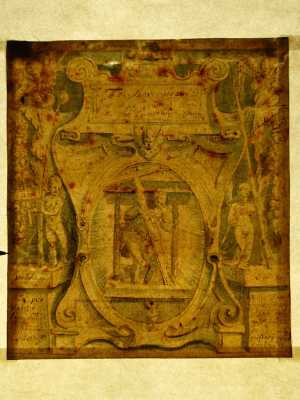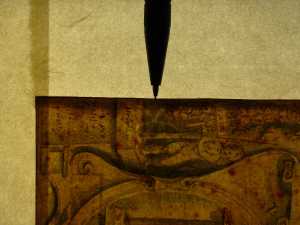Specificaties
| Titel | Christus in de wijnpers (titelblad) |
|---|---|
| Materiaal en techniek | Pen in bruine inkt, blauwgrijs gewassen, wit gehoogd, doorgegriffeld, kaderlijnen met de pen in bruine inkt |
| Objectsoort |
Tekening
> Tweedimensionaal object
> Kunstvoorwerp
|
| Locatie | Dit object is in het depot |
| Afmetingen |
Hoogte 116 mm Breedte 104 mm |
|---|---|
| Makers |
Tekenaar:
Karel van Mander
|
| Inventarisnummer | MB 1716 (PK) |
| Credits | Aankoop 1871(?) |
| Collectie | Tekeningen & Prenten |
| Verwervingsdatum | 1871 |
| Vervaardigingsdatum | in 1596 |
| Signatuur | geen |
| Watermerk | indistinct fragment, possibly the lower part of a shield with something below (on P2 from the left; vV, 4P, fine; for a discussion of the paper, see under inv. no. MB 1721). [AE] |
| Conditie | foxing met name in de bovenste helft |
| Inscripties | ‘Esa 63’ en ‘Torcular calcavi so/lus et de gentibus non / est vir meum esa 63’ (middenboven, resp. in een klein en een groot tekstvak), ‘INRI’ (in spiegelbeeld, linksmidden, in een tekstvak), ‘Hebr 12 / Qui pro / posito si/bi gaudio / sustinuit / crucem’ en ‘Esa 53 / vere lan/guores nos/tros ipse / […] tulit / et dolores / nostros ipse / portavit’ (resp. linksonder en rechtsonder, voor op de voetstukken), alle voorgaande inscripties eigenhandig, in pen in bruine inkt, ‘1’ (verso, linksonder, in potlood), ‘1’ (verso, linksonder, in pen in bruine inkt), ‘1026 / 12 St f Tetel [?] / Jolles’ (verso, midden, in potlood) |
| Merkteken | Museum Boymans Rotterdam (L.288) |
| Tentoonstellingen | Rotterdam 1996b; Rotterdam 2008 (coll 1); Parijs/Rotterdam 2014, nr. 57.1 |
| Interne tentoonstellingen |
Karel van Mander en het Haarlems maniërisme (1996) |
| Externe tentoonstellingen |
Bosch to Bloemaert. Early Netherlandish Drawings from the Museum Boijmans Van Beuningen (2014) |
| Onderzoek |
Toon onderzoek Nederlandse tekeningen uit de vijftiende en zestiende eeuw |
| Literatuur | cat. 1901, p. 47, nr. 518; Valentiner 1930, p. 86, nr. Z.3; Stampfle 1991, p. 14, onder nr. 21; Miedema 1995, p. 119, nr. D6; New Hollstein 1999a, appendix 2, nr. 7, en onder nr. 56; New Hollstein 2000a, dl. 1, p. 80, onder nr. 36; Collection Catalogue 2012 (online) |
| Materiaal | |
| Object | |
| Techniek |
Doorgriffelen
> Doorgegriffeld
> Tekentechniek
> Techniek
> Materiaal en techniek
Grijs gewassen
> Wassen
> Gewassen
> Tekentechniek
> Techniek
> Materiaal en techniek
Blauw gewassen
> Wassen
> Gewassen
> Tekentechniek
> Techniek
> Materiaal en techniek
|
| Geografische herkomst | Noordelijke Nederlanden > Nederlanden > West-Europa > Europa |


























